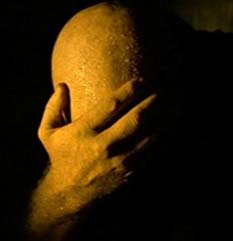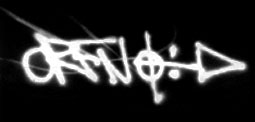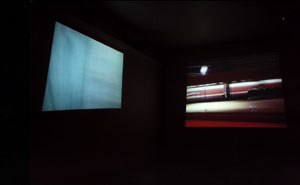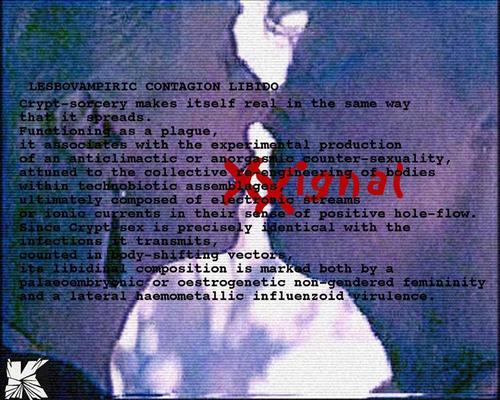January 20, 2005
Simon's interview with CCRU (1998)
(Was talking about this last night with Matt Woebot; it's no longer up on Simon's site, so I think it's time it got another airing. It's definitely a document of a moment in time, of moment in-becoming, and useful background for my Cyberfeminist Redux post, which should be up tomorrow).

RENEGADE ACADEMIA
Simon Reynolds
“CCRU retrochronically triggers itself from October 1995, where it uses Sadie Plant as a screen and Warwick University as a temporary habitat. ...CCRU feeds on graduate students + malfunctioning academic (Nick Land) + independent researchers +.... At degree-O CCRU is the name of a door in the Warwick University Philosphy Department. Here it is now officially said that CCRU ‘does not, has not, and will never exist’.”
—Communique from Cybernetic Culture Research Unit, November 1997.
Still nominally affiliated to the famously poststructuralist Philosophy Department of Warwick University, England, the Cybernetic Culture Research Unit is a rogue unit. It's the academic equivalent of Kurtz: the general in Apocalypse Now who used unorthodox methods to achieve superior results compared with the tradition-bound US military. Blurring the borders between traditional scholarship, cyberpunk sci-fi and music journalism, the CRRU are striving to achieve a kind of nomadic thought that to use the Deleuze & Guattari term—“deterritorializes” itself every which way: theory melded with fiction, philosophy cross-contaminated by natural sciences (neurology, bacteriology, thermodynamics, metallurgy, chaos and complexity theory, connectionism), academic writing that aspires to the future-shock intensity of jungle and other forms of post-rave music.
According to CCRU, its frenzied interdisciplinary activity—as seen in its Virtual Futures and Virotechnology conferences, and its journals ***collapse and Abstract Culture—disturbed Warwick's Philosophy Department, resulting in the termination of the unit. Just as Kurtz disappeared “up river” into the Vietnamese jungle, the CCRU have strategically withdrawn to their operational base in an apartment in nearby Leamington Spa. Institutionally, they've abandoned the university and linked up with renegade autodidacts and para-academic activists like O[rphan] D[frift>], Matt Fuller, and Kodwo Eshun.
CCRU was originally set up as a research unit for cybertheorist Sadie Plant, freshly recruited to Warwick from Birmingham University. With Plant's unexpected departure in early '97 to become a freelance author (the acclaimed cyberfeminist polemic Zeros + Ones, the self-explanatory Writing On Drugs), the role of director of the CCRU was taken over by her ex-lover Nick Land.
Land is the kind of “vortical machine” around which swirl all manner of outlandish and possibly apocryphal stories—allegedly he went through a phase of only talking in numbers, and was once “taken over” by three distinct entities? True or not, there's no denying the fact that, as Lecturer in Continental Philosophy, Dr. Land has been a “strange attractor” luring students to Warwick purely through his personal reputation and charisma. The Thirst For Annihilation: Georges Bataille and Virulent Nihilism, Land's sole book-length publication, is a remarkable if deranged mix of prose-poem, spiritual autobiography and rigorous explication of the implications of Bataille's thought. Prefiguring CCRU's struggles with university bureaucracy, the book drips with anti-academic bile, occasionally spilling over into flagellating self-disgust.
In the early Nineties, Land used to describe himself as a "professor of delirial engineering." After the relatively down-to-earth Sadie Plant's departure, Land has shepherded the CCRU into an uncanny interzone between science and superstition, blending Deleuze & Guattari and Norbert Wiener's cybernetics with his vast knowledge of the occult, chaos magick and parapsychology: the I Ching, Current 93 (Aleister Crowley's kundalini-like energy force), Kabbalist numerology, H.P. Lovecraft's Cthulhu Mythos, the eschatological cosmology of Terence McKenna, etc.

It's easy to see why Warwick University was consternated by CCRU's research. Explaining one of their numerological diagrams (“an attempt to understand concepts as number systems”), Land describes it as gift from “Professor Barker.” Inspired by Professor Challenger—the Conan-Doyle anti-hero reinvented by Deleuze & Guattari in A Thousand Plateaus:Capitalism & Schizophrenia—Barker appears to be a sort of imaginary mentor who reveals various cosmic secrets to the CCRU. “But we'd be a bit reluctant to say ‘imaginary’ now, wouldn't we?,” cautions Land. “We've learned as much—well, vastly more from Professor Barker—than supposedly ‘real’ pedagogues!” Including Barker's ‘Geo-Cosmic Theory of Trauma’. Following the materialist lead of Deleuze & Guattari, human culture is analyzed as just another set of strata on a geocosmic continuum. From the chemistry of metals to the cycles of capitalism, from the non-linear dynamics of the ocean to the fractalized breakbeat rhythms of jungle, the cosmos is an “unfolding traumascape” governed by self-similar patterns and fundamental processes that recur on every scale.
Libidinising “flows” and investing them with an intrinsically subversive power, Deleuze & Guattari have been criticised as incorrigible Romantics. CCRU develop this element of A Thousand Plateaus into a kind of mystic-materialism. Discussing what CCRU call “Gothic Materialism” (“ferro-vampiric” cultural activity which flirts with the inorganic and walks the “flatline" between life and death), Anna Greenspan talks about how “the core of the earth is made of iron, and blood contains iron,” about how the goal is to “hook up with the Earth's metal plasma core, which is the Body-Without-Organs.” Body-without-Organs (B-w-O) is the Deleuzian utopia, an inchoate flux of deterritorialized energy; Greenspan says they take the B-w-O as “an ethical injunction,” a supreme goal.
* * * *
O[rphan] D[rift>] also talk about “metal in the body” and seeking the B-w-O. Another Land-influenced theory-fiction collective, O[rphan] D[frift>] are CRRU's prime allies: they performed at the CCRU-organised Virtual Futures 96 conference at Warwick, and are set to stage an event in collaboration with CCRU/Switch at London's Beaconsfield Arts Centre, October of this year. Maggie Roberts and Ranu Mukherjee, the core of OD, originally met as Fine Art students at the prestigious-but-conservative Royal College, where their ideas about creating a form of multimedia-based synaesthetic terrorism oriented around “schizoid thinking,” pre-linguistic autistic states and man-machine interfaces proved way too radical. Formed in late 1994, OD was shaped by two mindblowing experiences: “experimentation with drugs and techno,” and a 1993 encounter with Nick Land.

“Before CCRU started at Warwick, Nick latched onto us very intensively for a while,” says Roberts. “We fed him image experience, tactile readings of the stuff he was buried in theoretically. He wanted his writing to kick in a much more experiential way. For us, there was something wonderful about having a man you could ring up and ask: ‘what's radiation?,’ ‘what's a black hole?’”
OD's collective debut was a multimedia installation at London's Cabinet Gallery. What began as a catalogue for the show escalated into an astonishing 437 page book, Cyberpositive. Like Plant's Zeros + Ones, Cyberpositive is a swarm-text of sampled writings that aren't attributed in the text. But where Plant offers footnotes; OD merely list the “asked” and “un-asked” contributors at the end. Published in 1995, Cyberpositive serves as a sort of canon-defining primer for the CCRU intellectual universe, placing SF and cyberpunk writers on the same level as post-structuralist theorists. “We treat Burroughs as clearly as important a thinker as any notional theorist,” says Nick Land, “At the same time, every great philosopher is producing an important fiction. Marx is obviously a science fiction writer.” For her part, Sadie Plant regards the Eighties cyberpunk novelists like Gibson and Cadigan as “more reliable witnesses,” precisely because, unlike theorists, “they don't have an axe to grind.”
The most highly-charged passages in Cyberpositive are the hefty chunks of Plant/Land writing and Roberts's and Mukherjee's evocations of the techno-rave-Ecstasy-LSD experience. “I used to write a lot in clubs, which probably looked really pretentious,” recalls Roberts. “Tracing what's happening in all the different sound channels and what they're doing spatially and physically to you.” The language veers from masochistic mortification of the flesh (“deep hurting techno,” “the meat is learning to know loss”) to imagery influenced by voodoo and shamanic possession (“white darkness,” “the fog of absolute proximity,” “psyclone,” “beautiful fear”). “It's trying to process the dissassembling of the self,” says Roberts. “Maybe what you're calling abject, we'd call melting. The violence of the sounds in techno, it’s like you're being turned inside out, smeared, penetrated.”

Despite her facial piercing and techno-pagan accoutrements, Roberts has a sort of burned-out, aristocratic air that suggests Marianne Faithfull circa 1969. A half-smile flickering on her lips, as if she’s privy to some kosmik joke, Roberts speaks in a faded falter—as though some unutterably alien zone of posthuman consciousness hasn't quite relinquished its hold. Which may be a pretty accurate description of the state of play. If CCRU have something of a cultic air about them, OD go a lot further. Combining Mayan cosmology with ideas about Artificial Intelligence, they seem to believe that humanity will soon abandon the “meat” of incarnate existence and become pure spirit.
Throughout Cyberpositive there’s the recurrent exhortation “we must change for the machines;” while the book ends with the declaration—“human viewpoint redundant.” Not only do OD reckon Charles Manson had some good ideas, their East London HQ contains several cages of snakes—proof of their determination to get really serious about voodoo rites. The obsession was sparked by Gibson’s Count Zero, in which cyberspace has spontaneously generated entities equivalent to the loa (the spirit-gods of voudun cosmology). Throughout the interview, a shaven-headed OD member called Rich sits with baby boa constrictors wrapped around his body. His other contribution to the evening is to make some sandwiches—daintily quartered, but containing peanut butter mixed with sardines. "Too radical for me", I confess after one nibble. Rich's eyes
light up triumphantly: Mind-Game Over.
* * * * * *
“Cyberpositive” was originally the title of an essay by Sadie Plant and Nick Land. First aired at the 1992 drug culture symposium Pharmakon, “Cyberpositive” was a gauntlet thrown down at the Left-wing orthodoxies that still dominate British academia. The term “cyberpositive” was a twist on Norbert Wierner's ideas of “negative feedback” (homeostasis), and “positive feedback” (runaway tendencies, vicious circles). Where the conservative Wiener valorized “negative feedback,” Plant/Land re-positivized positive feedback—specifically the tendency of market forces to generate disorder and destabilize control structures.
“It was pretty obvious that a theoretically Left-leaning critique could be maintained quite happily but it wasn't ever going to get anywhere,” says Plant. “If there was going to be scope for any kind of....not ‘resistance,’ but any kind of discrepancy in the global consensus, then it was going to have to come from somewhere else.” As well as Deleuze & Guattari, another crucial influences were neo-Deleuzian theorist Manuel De Landa's idea of “capitalism as the system of antimarkets.” Plant and the CCRU enthuse about bottom-up, grass-roots, self-organizing activity: street markets, “the frontier zones of capitalism,” what De Landa calls “meshwork,” as opposed to corporate, top-down capitalism. It all sounds quite jovial, the way CCRU describe it now—a bustling bazaar culture of trade and “cutting deals.” But “Cyberpositive” actually reads like a nihilistic paean to the “cyberpathology of markets,” celebrating capitalism as “a viral contagion” and declaring “everything cyberpositive is an enemy of mankind.” In Nick Land’s essays like “Machinic Desire” and “Meltdown,” the tone of morbid glee is intensified to an apocalyptic pitch. There seems to be a perverse and literally anti-humanist identification with the “dark will” of capital and technology, as it “rips up political cultures, deletes traditions, dissolves subjectivities.”
This gloating delight in capital's deterritorializing virulence is the CCRU’s reaction to the stuffy complacency of Left-wing academic thought. “There's definitely a strong alliance in the academy between anti-market ideas and completely scleroticised, institutionalized thought,” says CCRU's Mark Fisher. “It's obvious that capitalism isn’t going to be brought down by its contradictions. Nothing ever died of contradictions!” Exulting in capitalism's permanent “crisis mode,” CCRU believe in the strategic application of pressure to accelerate the tendencies towards chaos.

Hungry for intellectual reasons-to-be-cheerful, CCRU simultaneously renounce postmodernism's wan fatalism (the idea that we're at the end of everything) and the guilt-wracked impotence of the Left. In the process, they've jettisoned the concept of “alienation” in both its Marxist and Freudian senses. They speak approvingly of “surplus value,” sublimation and commodity-fetishism as creative tendencies. Where “Cyberpositive” noted how how runaway capitalism had accessed “inconceivable alienations,” CCRU's collectively written essay “Swarmachines” goes further and climaxes with the boast: “alienated and loving it.” The idea, says Fisher, comes from a mix-and-blend of Lyotard and Blade Runner—“the proletariat as this synthetic class, and revolution that's on the side of the synthetic and artificial. The concept of ‘alienation’ depends on the notion that there's some authentic essence lost through the development of capitalism. But according to Barker, everything's already synthetic.” If reality really is a bio-mechanical, geocosmic continuum, there's no reason to resist capitalism’s escalating dynamic of anti-naturalism: addiction to hyper-stimulus, the creation of artificial desires.
The mania of CCRU's texts—with their mood-blend of euphoric anticipation and dystopian dread—is contagious. Much of the time they're trying to create a “theory-rush” that matches the buzz they get from contemporary sampladelic dance music; they describe, half-jokingly, what they do as “sub-bass materialism.” “The musical model is really key to us,” says Land. “It's absurd to say that music doesn't represent the real and therefore it’s an empty metaphor. Every theorist who hasn’t a real place for music ends up with one-dimensional melancholia.” Not only do the CCRU derive a lot of their energy from music (specifically drum & bass and UK garage, which one member of the unit actually makes and Djs under the name Kode 9) but popular culture is where their ideas seem most persuasive. Right from its late Eighties beginnings, rave culture’s motor has been anarcho-capitalist: from promoters throwing illegal parties in warehouses to drug dealing. Even after its co-optation by the record and clubbing industries, rave music's cutting edge comes from small labels, cottage-industry producers with home studios, specialist record stores, pirate radio. Sadie Plant attributes these bottom-up economic networks to the end of welfare and “dependency culture,” which forced people “to get real and find some ways of surviving” but also to invent “new forms of collectivity” (the micro-utopian communality of the rave).
As well as being galvanized by music, the CCRU are influenced by the theory-driven leading edge of music journalism. One of their associate members is Kodwo Eshun, contributor to iD and The Wire, and author of the book More Brilliant Than The Sun: Adventures In Sonic Fiction (Quartet), a study of Afro-futurist music from Sun Ra to 4 Hero. Eshun describes himself and the CCRU as “concept-engineers.” “Most theory contextualises, historicizes and cautions; the concept-engineer uses theory to speculate, excite and ignite,” Eshun proclaims. Like a DJ/producer, the concept-engineer is “a sample-finder,” free to suspend belief in the ultimate truth-value of a theory and simply use the bits that work (in the spirit of Deleuze & Guattari's offering up of A Thousand Plateaus as tool-kit rather than gospel).
“Concept-engineer” is a good tag for the outerzone of “independent researchers” to which CCRU is connected. Renegade autodidacts like Howard Slater, a Deleuze-freak whose techno-zine break/flow brilliantly analyzes rave culture in terms of “surges of intensity” and “impulsional exchanges.” And like Matthew Fuller, a media theorist/activist with a background in anarchist politics and links to the hacker underground. Fuller’s CV of cultural dissidence includes flypostering, a non-Internet bulletin board called Fast Breeder, the scabrous freesheet Underground, and a series of anarcho-seminars dedicated to the praxis of media terrorism. Fuller also put out the anthology Unnatural: Techno-Theory For A Contaminated Culture, which included Plant/Land's “Cyberpositive.”
Discussing his own cyber-theory writings, Fuller talks about dismantling traditional “modes of political address” and developing a sort of post-ideological realpolitik of resistance. A true concept-engineer, he believes in ransacking theory texts for task-specific ideas. “Publishers like Autonomedia and Semiotexte produce material that you don't have to be an academic to get into, so it circulates outside those milieux. When I give presentations at academic events, it's easy to see I'm in a more powerful position than the academics—I can steal all the advantages of their discipline, plus do something else with it that fucks it up totally.” Noting that Deleuze & Guattari are already being institutionalized into “the most dreary, saintly area of discourse,” Fuller says he’s dedicated to “cracking open those texts again, thinkers who originally opened stuff up to delirium and the irrational. I mix up different linguistic registers and narrative strategies so that the text writhes in the hands of the reader. In that respect, there's a lot more to be learned from fiction than theory.” Here Fuller chimes in with Sadie Plant, whose forthcoming Writing On Drugs will include a fictional component, and who hopes her future books will become “pure fiction.”
“The most enjoyable aspect of CCRU is that they are a gang—Ph.D. students with attitude!,” says Eshun. Loathing the “necrotic side of philosophy, the chewing-over of dead thinkers’ entrails,” and bored limp by the “delibidinising” atmosphere of seminars, CCRU used to attend academic events, claims Eshun, expressly “in order to disrupt, undermine and ridicule.... They'd get into pitched battles with Derrideans!"
Weary of such sports, Plant and CCRU have all enthusiastically embraced the idea of escaping “institutional lockdown” by going freelance. The CCRU hope to become a kind of independent think-tank, selling “commodities” on the intellectual free market—like their strikingly designed Abstract Culture (each “swarm” consists of five separate monographs bundled together) and, in the future, CD's, CD-ROM's and books.
It seems unlikely, however, that Plant and her erstwhile cronies will rejoin forces once they’re out in the freemarket wilderness. Some kind of ideological rift seems to have occurred. Plant says she couldn’t really go along with the trip into numerical mysticism, not least because she didn't like finding herself “in the role of the sensible, conservative one—not a role I'm used to!” CCRU, for their part, seem to have resented their guru’s premature departure from Warwick. “Nick Land's hermetic, he wants acolytes,” says Eshun. “Whereas Sadie’s this total communicator. Zeros + Ones is the return of the grand narrative with a vengeance. I can’t think of any other writer with the same ambition. Sadie wants the world and I think she'll get it.”
For CCRU work, post-CCRU activity, and allied ‘renegade autodidacts’ check out these sites:
Cybernetic Culture Research Unit -- http://www.ccru.net/
K-Gothic -- http://www.k-gothic.net/
Datacomb -- http://www.k-punk.net/k-punk.net
K-Punk -- http://k-punk.abstractdynamics.org/
Hyperdub -- http://www.hyperdub.com/
Kode 9 -- http://www.ccru.net/kode9.htm
Abstract Machines -- http://www.ccru.net/abstractmachines.htm
Orphan Drift -- http://www.orphandrift.com/
Matthew Fuller -- http://www.autonomedia.org/behindtheblip/index.html
(originally published in an abridged version by Springerin magazine, Vienna, 1999)
